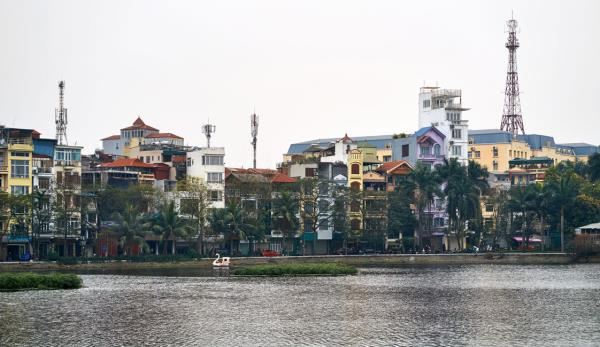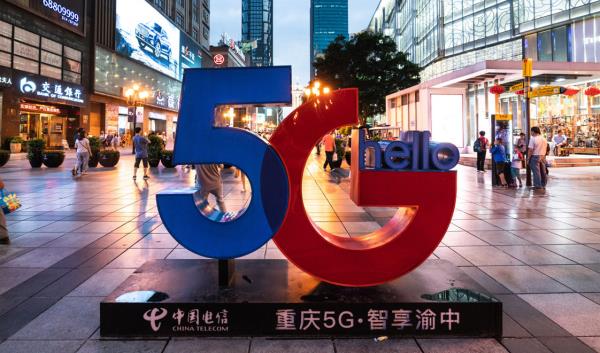16 June 2023

5G is set to revolutionise the world with high-speed connectivity, enabling services the likes of which have never been seen. From smart cities and IoT to communications on the move, the future looks bright. Nonetheless, 5G rollout across southern Asia is fragmented – Amy Saunders finds out why
Affordable access to internet connectivity is considered a basic human right by many. Demonstrating its absolute necessity during the COVID-19 pandemic, wherein it became a lifeline for work, leisure, healthcare, learning, etc., the internet has surpassed all expectations in enabling modern life.
Despite this, coverage remains uneven across the globe, with many developing nations remaining at less than 50%. Even those nations with ‘good’ coverage are host to large digital divides between the inner cities – often home to high-speed connectivity – and remote regions, often poorly served or completely unconnected.
Data from Ookla’s April 2023 Speedtest Global Index reveals that Singapore, The Maldives, Vietnam, Thailand, and Malaysia all boast mobile download speeds exceeding 30Mbps. At the other end of the scale, typical mobile download speeds in Nepal and Sri Lanka are less than 15Mbps – lower than the recommended speed to stream UHD content. Clearly, there’s work to be done.
A call to action
“Ensuring 5G is fully available across the entire southern Asian region is of critical importance for the development and growth of these areas,” states Eran Shalev, VP, head of product, Parallel Wireless. “The impact of 5G goes far beyond just faster download speeds or improved network performance. It has the power to transform industries, enable new technologies, and bring people closer together.”
Indeed, 5G is not just the next generation in a line of mobile generations, but an entire ecosystem of technologies, products, solutions, and processes to facilitate the daily life of communities, explains John Tenidis, marketing director of Intracom Telecom’s wireless solutions portfolio.
“5G has an impact equal and comparable to that of the industrial revolution,” asserts Tenidis. “5G is a tool for the population to improve quality and increase prosperity for its current and the future generations. It can be used in the economic, political, social, industrial, academic, professional life of the communities and its integration requires skills that must be developed locally for local needs.”
Shalev agrees, citing that deployment across all parts of southern Asia can create new opportunities in different segments and bring progress to new areas. “People in remote and rural areas of southern Asia will be able to access the same high-speed internet and advanced technologies as their urban counterparts, and at the same time enjoy the advantages of new industries, more tourism, better education, and improved health care.”
“Establishing equality to the right of communication is fundamental for the prosperity of communities,” concurs Tenidis. “Things like smart education, smart agriculture, smart business, smart entertainment, and AI have their foundation on the 5G network. 5G is the tool to bring prosperity to the entire population. The rural and non-densely populated areas have always been the Achilles’ heel of progress.”
Vaibhav Magow, vice president, international division, Hughes, however, believes that “it’s not important that 5G be fully available across the entire southern Asia region – or any region, for that matter. This is because there are still many places where 4G is not yet available!”
Indeed, according to the GSMA, in southern Asia some 70 million people are on the edge of coverage of mobile service and another 66 million people live without any mobile coverage at all.
“Rather, it’s important that reliable connectivity be available to anyone who wants it, and that’s where satellite plays such an important role – both for direct-to-home internet access and for backhauling cellular traffic to extend network reach beyond where cable and fibre connect the towers,” says Magow.
Remote and rural communities
The natural landscape of southern Asia – spanning more than 4 million square km – features a wide array of physical characteristics, from deserts, mountains, and islands through to dense jungles and humid swamps. Delivering 5G connectivity to such regions, often remote and rural, poses significant challenges; however, with innovative strategies and partnerships, it is possible to overcome these and bring the benefits of 5G technology to even the most remote corners.
Some of the greatest challenges include lack of infrastructure like fibre and cell towers, which are costly and time-consuming to build; limited electricity supply, which makes operations and maintenance tricky; affordability for end users; lack of skilled personnel for deployment; and handset availability and pricing.

Magow agrees that delivering 5G (and even 4G) cellular service to remote and rural southern Asian locations is hampered by the lack of wired access to connect the cell towers. “It’s the same challenge that has existed for years because the economics are such that it’s cost-prohibitive for a mobile network operator to invest building out the infrastructure in areas of low population density.”
“The topography and infrastructure of these areas combined with the nature of the majority of the 5G new spectrum bands - high band and short range - can make it difficult to deploy the necessary infrastructure and technologies to support 5G networks,” concurs Shalev.
These challenges should be used as the driver to find innovative solutions to overcome obstacles, says Shalev, by exploring low-cost and high-performance equipment options, for example.
“Advanced antenna system technologies, Massive MIMO and beam forming technologies can be easily deployed and increase spectrum efficiency, increasing satellite coverage to reach remote areas, and utilising artificial intelligence and automation to optimise network deployment,” says Shalev. “Local governments must allocate the maximum possible spectrum as well as collaborate with the stakeholders to ensure that all communities have access to the necessary infrastructure and resources to support the deployment of 5G networks. By working together and leveraging the latest technologies, it is possible to overcome these challenges and bring the power of 5G to all corners of southern Asia.”
5G does present one important opportunity though, according to Magow: “and that is, in many countries, including Bangladesh, India, and Nepal, operators are required to extend broadband connectivity into rural areas as part of their 5G licenses.”
With such a varied natural environment presenting a host of challenges, the best technical solutions for delivering broadband-speed connectivity also vary from country to country, city to city, and even town to town.
“There should be a combination of technologies to provide the greatest solution for remote and rural 5G access in southern Asia,” says Shalev. “Small cell technology can be deployed in urban areas, while satellite-based solutions can be used to reach remote and rural locations.”
Magow agrees that satellite has a key role to play given the often-remote locations: “shared VSAT solutions such as cellular backhaul and community WiFi hotspots continue to help bridge the digital divide in rural and remote areas and represent a reliable and efficient way to extend mobile network service – including 5G into these populations. With the launch of new low Earth orbit systems, such as OneWeb, mobile operators will have yet another option for powering these solutions – with lower latency and higher speeds.”
Meanwhile, next generation fixed wireless access (ngFWA) combined with a reliable transport solution could also have a significant impact on the southern Asian market.
“This technology has the potential to provide high-speed internet access to even the most remote areas where traditional broadband is not available,” outlines Shalev. “ngFWA is a cost-effective and easy-to-deploy solution that provides reliable connectivity for residential and business customers.”
By leveraging this technology, the digital divide can be bridged, and the benefits of high-speed internet access felt across all parts of southern Asia. “This can help to unlock new opportunities for economic growth and development, while also improving the quality of life for people living in these areas,” adds Shalev.

Money, money, money
The monetisation of connectivity services is essential for operators to continue to deliver high-speed internet services to the population of southern Asia, and indeed, the rest of the world.
Tenidis believes that, at first, 5G monetisation may be comparable with the challenges experienced during the rollout of 4G. The effective monetisation of 5G services and capabilities can be challenging and costly, “however, emerging business models, although they cannot be accurately predicted today, will lay the first stone for new synergies and cross-product offerings bringing enhanced commercial transactions. 5G will eventually enable numerous direct or indirect business relationships (e.g. B2B2X) among CSPs, third parties and the end customers. The most common of such models, also applicable today, refers to third party digital content offered to consumers by the CSPs.”
Monetising remote and rural 5G offerings can be a particularly significant challenge for service providers due to the low population densities and island topologies involved. Shalev recommends:
- Providing customised services to niche markets such as agriculture or mining industries that are prevalent in these areas. These industries often have unique connectivity needs, and service providers can tailor their offerings to meet these needs.
- Service providers can explore opportunities to partner with local governments to provide connectivity to underserved areas, which can help to attract new businesses and stimulate economic growth. This can be performed in conjunction with promotions from the governments that would benefit from the rise in education, health, industries, and commerce in these remote areas.
- Leveraging the latest technologies such as advanced radio and automation to optimise network deployment and reduce operational costs. This can help to improve the profitability of remote and rural 5G offerings.
- Offering value-added services such as remote healthcare or online education, which can help to increase demand.
“Adopting these strategies will allow service providers to monetise remote and rural 5G offerings and bring the benefits of high-speed connectivity to all parts of southern Asia,” concludes Shalev.
To promote the rollout of 5G connectivity throughout the region, governments can provide incentives for service providers to balance the shortfall in profitability in rural and low-density areas. Of course, each country has its own governing body with their own set of priorities, which may not be focused on digital enhancement and the positive impact on the economy as a whole.
Another option to help enhance the coverage footprint of 5G in southern Asia, also relevant to other world regions, is infrastructure sharing among providers. This can reduce the cost of deployment and increase the coverage area, which also cuts the risk of over-investing in infrastructure in areas with low population densities.
Leaving no one behind
It’s clear that there is no single answer to ensure affordable access to 5G (or, indeed, even 4G) connectivity to the entire population of southern Asia. However, with broadband-speed connectivity now considered a vital component of modern life the world over, governments and service providers must act, through a variety of approaches, to ensure that no one is left behind. The direct and indirect benefits of internet access to the economy have been proven time and time again, making now the time for all those in the chain to collaborate to deliver 5G to where it’s needed most.






